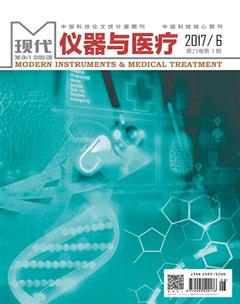右美托咪定和咪达唑仑用于困难气道患者清醒插管的比较
杨木泽+赵峰
[摘 要] 目的:比較右美托咪定和咪达唑仑用于困难气道患者清醒插管的效果。方法:选择2015年10月—2016年10月于我院行择期全麻手术的困难气道患者60例,随机分为A组(右美托咪定组,n=28)、B组(咪达唑仑组,n=32)。2组患者均采用表面麻醉下纤支镜辅助气管插管。记录2组患者麻醉前(T1)、纤支镜进入咽腔时(T2)、纤支镜进入声门时(T3)、插管即刻(T4)、插管后1min(T5)、插管后3min(T6)、插管后5min(T7)时心率(HR)、平均动脉压(MAP)、脉搏氧饱和度(SPO2)以及Ramsay镇静评分的变化,分别于T1、T4、T6时刻监测患者外周静脉血中去甲肾上腺素(NE)、肾上腺素(E)、皮质醇(Cor)的浓度,统计2组患者插管过程中及术后24h不良反应。结果:T3~T7 A组HR、MAP明显低于B组且A组Ramsay镇静评分优于B组,差异有统计学意义,p<0.05;T4、T6时间点A组患者NE、E、Cor明显低于B组,差异有统计学意义,p<0.05;A组躁动和咽喉疼痛的发生率明显低于B组,差异有统计学意义,p<0.05。结论:右美托咪定用于困难气道患者清醒气管插管不仅镇静效果优于咪达唑仑,而且能够有效抑制患者的应激反应,减少不良反应的发生。
[关键词] 右美托咪定;咪达唑仑;困难气道;清醒气管插管
中图分类号:R614 文献标识码:A 文章编号:2095-5200(2017)03-048-03
DOI:10.11876/mimt201703021
[Abstract] Objective: This study was conducted to compare the effect of dexmedetomidine and midazolam on the awake intubation of patients with difficult airway. Methods: 60 patients with difficult airway surgery from October 2015 to October 2016 were enrolled in this study, and they were randomly divided into group A (dexmedetomidine group, n=28) and group B (midazolam group, n=32). Both two groups of patients underwent endotracheal intubation under topical anesthesia with bronchoscopy. The heart rate (HR), mean arterial pressure (MAP), pulse oxygen saturation (SpO2) and Ramsay sedation score at the time points of pre-anesthesia (T1), the bronchoscope entering into the pharyngeal cavity (T2), the bronchoscope entering into the glottis (T3), intubation immediately (T4), 1 min after intubation (T5), 3 min after intubation (T6), 5 min after intubation (T7) of both groups were recorded respectively. The patients levels of norepinephrine (NE), adrenaline (E) and cortisol (Cor) in venous blood were monitored at the time points of T1, T4 and T6, and the adverse reactions were observed during the intubation and postoperative 24 h. Results: The HR and MAP at the time points of T3-T7 in group A were significantly lower than those of group B, the Ramsay sedation score of group A was better than that of group B, and the difference was statistically significant (P<0.05). The levels of NE, E and Cor of group A at the time points of T4 and T6 were significantly lower than those in group B, the difference was statistically significant (P<0.05); the incidences of restless and throat pain in group A was significantly lower than those in B group, the difference was statistically significant (P<0.05). Conclusions: Dextromethorphan for the awake intubation in patients with difficult airway not only has better sedative effect than midazolam, but also can effectively inhibit the stress response and reduce adverse reactions.
[Key words] dexmedetomidine; midazolam; difficult airway; awake intubation
困难气道是麻醉诱导期的重大挑战之一,正确的气道管理是患者麻醉手术成功的关键[1]。纤支镜引导下的清醒气管插管是困难气道最常用的处理方法[2]。清醒气管插管常在表面麻醉下进行,但插管过程的疼痛刺激等不适不仅会增加患者的抵抗,降低插管的成功率,而且会导致患者的血流动力学波动,增加不良反应的发生率,严重者甚至影响患者的生命安全[3-4]。右美托咪定是一种选择性的α2受体激动剂 [5-6];咪达唑仑具有镇静、催眠、抗焦虑、抗癫痫、顺行性遗忘的作用[7-8],二者均能有效降低外源性刺激引起的交感神经反应,降低麻醉后心脑血管等不良反应的发生。本研究将比较右美托咪定和咪达唑仑用于困难气道患者清醒插管的效果。
1 资料与方法
1.1 一般资料
选择2015年10月—2016年10月于我院行择期全麻手术的困难气道患者60例,40~60岁,ASAI~III级 ,随机分为A组(右美托咪定组,n=28)、B组(咪达唑仑组,n=32)。2组患者术前均进行术前访视且均确诊为困难气道(甲颏距离<0.6cm,张口度<3指,Mallampati分级为三级以上)。排除有严重心肺疾病、肝肾功能电解质异常、凝血功能异常,不能耐受麻醉手术的患者。2组患者一般情况(性别比、年龄、身高、体重)相比差异无统计学意义,p>0.05,具有可比性。本研究经我院伦理委员会批准,且所有患者及家属均签署知情同意书。
1.2 方法
2组患者均采用2%利多卡因咽喉喷雾器对咽喉部进行表面麻醉,1%丁卡因3mL环甲膜穿刺,1%麻黄碱收缩鼻腔粘膜。A组患者于气管插管前10min持续静脉泵注右美托咪定1ug/kg,10min后以0.5ug.kg-1.h-1持续泵注;B组患者于气管插管前5min给予咪达唑仑30ug/kg。2组患者均在纤支镜引导下经鼻气管插管,男性患者选择7.0号或7.5号气管导管,女性患者选择6.5号或7.0号气管导管,将气管导管和纤支镜表面使用石蜡油充分润滑,再将纤支镜沿患者一侧鼻腔垂直插入,边向下进入边调整角度寻找会厌及声门,完全暴露清楚后将纤支镜插入支气管的上1/3处并将气管导管顺式插入声门,退出纤支镜,3min后接麻醉机行机械通气,静脉给予依托咪酯0.2mg/kg,舒芬太尼0.5ug/kg,
顺式阿曲库铵0.2mg/kg,术中均采用静吸复合麻醉维持
麻醉。
1.3 观察指标
记录2组患者麻醉前(T1)、纤支镜进入咽腔时(T2)、纤支镜进入声门时(T3)、插管即刻(T4)、插管后1min(T5)、插管后3min(T6)、插管后5min(T7)时心率(HR)、平均动脉压(MAP)、脉搏氧饱和度(SPO2)以及Ramsay镇静评分的变化,并分别于T1、T4、T6时刻监测患者外周静脉血中去甲肾上腺素(NE)、肾上腺素(E)、皮质醇(Cor)的浓度,统计2组患者插管过程中及术后24h不良反应(呛咳、恶心呕吐、躁动、呼吸抑制、心律失常、咽喉疼痛、声嘶)的发生情况。
1.4 统计学方法
采用SPSS19.0统计学软件进行分析,计量资料采用t检验或方差分析,计数资料采用χ2检验,p<0.05为差异有统计学意义。
2 结果
2.1 2組不同时间点生命体征及Ramsay评分比较
2组患者T1~T7时间点SPO2相比差异无统计学意义,T1~T2时间点HR、MAP相比差异无统计学意义,T3~T7 A组患者HR、MAP明显低于B组患者且A组患者的Ramsay镇静评分优于B组患者,差异有统计学意义,p<0.05,见表1。
2.2 不同时间点NE、E、Cor浓度比较
T1时间点2组患者NE、E、Cor相比差异无统计学意义,T4、T6时间点A组患者NE、E、Cor明显低于B组患者,差异有统计学意义,p<0.05,见表2。
2.3 不良反应发生情况
A组呛咳、躁动、咽喉疼痛各1例,B组呛咳3例、恶心呕吐2例、躁动8例、呼吸抑制1例、心律失常1例、咽喉疼痛8例。A组各反应发生率均低于B组,且躁动和咽喉疼痛的发生率差异有统计学意义,p<0.05。
3 讨论
纤支镜引导下清醒气管插管是处理困难气道的有效方法之一。临床上清醒气管插管常在咽喉部表面麻醉后进行,但困难气道患者气道情况复杂,插管难度大,插管过程中纤支镜可能会引起患者气道损伤,且纤支镜引起的咽喉部异物感及局部麻醉药物的刺激会增加患者的应激,引起患者心率增快、血压增加,进而增加患者的恐惧感和抵抗反应,降低插管成功率[9-11]。当机体受到外源性或内源性刺激后,血液中NE、E、Cor分泌增加,导致患者血流动力学波动[12-13]。
右美托咪定广泛应用于麻醉和重症监护患者的镇静[14]。咪达唑仑是临床麻醉中广泛应用的镇静药物之一[15]。
本研究结果显示2组T1~T7时间点SPO2相比差异无统计学意义,表明两种药物在合适剂量下对患者的呼吸影响无差异,由于T1~T2时间点纤支镜对患者的刺激轻,因而2组患者HR、MAP、NE、E、Cor相比差异无统计学意义。T3~T7时间点A组患者HR、MAP明显低于B组患者且A组患者的Ramsay镇静评分优于B组患者,T4、T6时间点A组患者NE、E、Cor明显低于B组患者,原因为咪达唑仑无镇痛作用,而右美托咪定选择性激动α2受体,镇静镇痛效果好,因而能更好地抑制患者的应激反应[16]。由于右美托咪定镇静镇痛效果好,因而A组患者躁动和咽喉疼痛的发生率比B组低且差异有统计学意义。
综上,右美托咪定用于困难气道患者清醒气管插管不仅镇静效果优于咪达唑仑,而且能够有效抑制患者的应激反应,减少不良反应的发生。
參 考 文 献
[1] Dasta JF, Kane-gill SL, Pencian M, et al. A cost-minimization analysis of dexmedetomidine compared with midazolam for long-term sedation in the intensive care unit[J]. Crit Care Med, 2010,38(2):497-503.
[2] Boyd B C, Sutter S J. Dexmedetomidine sedation for awake fiberoptic intubation of patients with difficult airways due to severe odontogenic cervicofacial infections[J]. J Oral Max Sur, 2011, 69(6): 1608-1612.
[3] Bergese S D, Bender S P, McSweeney T D, et al. A comparative study of dexmedetomidine with midazolam and midazolam alone for sedation during elective awake fiberoptic intubation[J]. J clin Anesth, 2010, 22(1): 35-40.
[4] Ghaderian M, Sabri MR, Ahmadi AR. Precutaneous retrieval of an intracardiac central venous port fragment using snare with triple loops[J]. J Res Med Sci, 2015,20(1):97-99.
[5] Boyer J. Treating agita on with dexmedetomidine in the ICU[J]. Dimenscrit Care Nurs, 2012,28(3):102-109.
[6] Neumann M M, Davio M B, Macknet M R, et al. Dexmedetomidine for awake fiberoptic intubation in a parturient with spinal muscular atrophy type III for cesarean delivery[J]. Int J Obstet Anesth, 2009, 18(4): 403-407.
[7] Tsai C J, Chu K S, Chen T I, et al. A comparison of the effectiveness of dexmedetomidine versus propofol target‐controlled infusion for sedation during fibreoptic nasotracheal intubation[J]. Anaesthesia, 2010, 65(3): 254-259.
[8] Albuquerque VB, Arqujo MA, Ferreira GT, et al. Effects of ropivacaine combined with morphine at 0.15 and 0.2mg in biches undergoing qpidural anesthesia[J]. Acta Cir Bras, 2015,30(3):222-238.
[9] Gerold KB, Gibbons ME, Fisettere JR, et al. Reviw, clinical update, and practice guidelines for excited delirium syndrome[J]. J Spec Oper Med, 2015,15(1):62-69.
[10] Cheung C W, Ng K F J, Liu J, et al. Analgesic and sedative effects of intranasal dexmedetomidine in third molar surgery under local anaesthesia[J]. Br J Anaesth, 2011, 107(3): 430-437.
[11] Aksu R, Akin A, Bi?er C, et al. Comparison of the effects of dexmedetomidine versus fentanyl on airway reflexes and hemodynamic responses to tracheal extubation during rhinoplasty: A double-blind, randomized, controlled study[J]. Curr Ther Res, 2009, 70(3): 209-220.
[12] Kaskinoro K, Maksimow A, L?ngsj? J, et al. Wide inter-individual variability of bispectral index and spectral entropy at loss of consciousness during increasing concentrations of dexmedetomidine, propofol, and sevoflurane[J]. Br J Anaesth, 2011, 117(23): 430-437.
[13] Mahmoud M, Jung D, Salisbury S, et al. Effect of increasing depth of dexmedetomidine and propofol anesthesia on upper airway morphology in children and adolescents with obstructive sleep apnea[J]. J Clin Anesthesia, 2013, 25(7): 529-541.
[14] Garavaglia M M, Das S, Cusimano M D, et al. Anesthetic approach to high-risk patients and prolonged awake craniotomy using dexmedetomidine and scalp block[J]. J Neurosurg Anesthesiol, 2014, 26(3): 226-233.
[15] Gupta K, Jain M, Gupta P K, et al. Dexmedetomidine premedication for fiberoptic intubation in patients of temporomandibular joint ankylosis: A randomized clinical trial[J]. Saudi J Anaesth,2012, 6(3): 219-223.
[16] Emir S, Erturgut P, Vidinlisan S. Compariso of granisetron plus dexmethasone versus an antiemetic cocktail containing midazolam and diphenhydramine for chemotherapy induced nausea and vimiting in children[J]. Indian J Med Paediatr Oncol, 2013,34(4):270-273.

